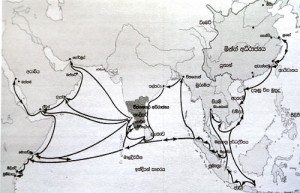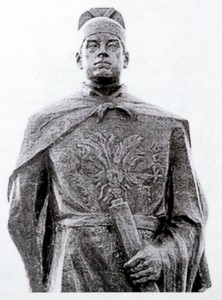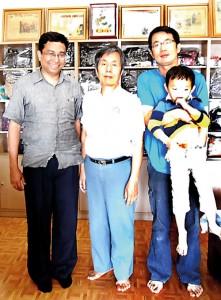On the trail of a Chinese Admiral
View(s):Paediatrician Dr. Ajith Amarasinghe tells Kumudini Hettiarachchi how he has combed Kotte, Jaffna and even travelled to Taiwan in his quest to uncover a tale of trade and palace intrigue in the 15th century
Across the oceans, sails billowing, the majestic fleet of the Chinese Navy with a formidable Admiral at its helm came bearing gifts and also goods for trading many a century ago. Ruthless they became, however, the moment there was even a semblance of a non-cordial welcome on the part of the king of southern Ceylon.

Dr. Ajith Amarasinghe Pic by M.A. Pushpa Kumara
It was the 1400s and the confrontation between the mighty eunuch-Admiral Zheng He and Vira Alakesvara changed the destiny of Sri Lanka, with the incredible impunity of a foreign force capturing the monarch in his own territory and transporting this regal prisoner to the court of Emperor Zhu-di of the Ming dynasty in faraway Nanjing, China.
The plot within the plot and the sub-plot of another Missing Prince have been the obsession of a Consultant Paediatrician by day and ‘hobby-historian’ in the early hours of the morning, while the world is in deep slumber.
The quest has been long and arduous for Dr. Ajith Amarasinghe, who has roamed Kotte looking for clues, taken the route from Raigama to Jaffna and finally met up with the descendants of a local prince in Taiwan. All this has been preceded by going over documents with a fine-tooth comb, scanning the internet and mail-ordering books from across the world.
His labours have paid off and he has not only uncovered the paper trail about how King Alakesvara was captured by Chinese soldiers but also how it smacked of a ‘palace coup’.
The tale unravels, with innumerable threads being woven together by Dr. Amarasinghe to make the whole fantastic and colourful picture of Ceylon in the 1400s come alive. It is on Tuesday morning, ensconced in the first floor study of Dr. Amarasinghe’s Polhengoda home surrounded

The reach of the Chinese Fleet
by books and bulging files that we become privy to what his labours have been.
Having been lured by the mystery around the abduction of Alakesvara by the Chinese, Dr. Amarasinghe had been disconcerted to find contrary versions about this history-changing event. Some history books indicated that Alakesvara was at Gampola when he was captured, others that it was Kotte and the most recent ones that it was at Raigama.
How the Chinese army could capture a King from his own territory baffled and intrigued him. That was nearly three years ago and onto the internet he went and discovered several

Admiral Zheng He
books which detailed the incident. He also read up all accounts of people who had come to Ceylon.
“But none who dealt with this event had access to original Chinese documents linked to this capture because they had not been translated at that time,” points out Dr. Amarasinghe, while the Chinese who documented it faced a similar situation.
It was then that the hobby-historian in him could not resist the challenge. With the burning desire to become an archaeologist as a child, fuelled by the fact that he and his family had lived in heritage-rich cities such as Anuradhapura as his father was a judge, he had always dreamt of gaining the skill to decipher sel-lipi (stone inscriptions).
Ruefully he says that “circumstances” made him a doctor, not family pressure but urgings by his teachers, putting paid to his dreams of becoming an archaeologist. As a doctor, it was for relaxation that he delved into history.
With much debate currently over the motives of China with regard to its interest in Sri Lanka, Dr. Amarasinghe who flips back the pages of history to the 1400s is quick to point out that during that era it was not only to Ceylon that the Chinese Fleet of 300 ships with 28,800 soldiers sailed but to many ports as far as Africa. The Chinese Fleet, the largest in the world before World War I, was not bent on colonising these countries but on establishing and strengthening maritime trade links.
Seven naval expeditions were carried out at the behest of the Chinese Emperor, according to him, reaching as far as Calicut, with Admiral Zheng He (also known as Cheng Ho) arriving with gifts such as gold, silver, porcelain and silk while also being showered with exotic stuff such as ostriches, zebras, camels, ivory and even a giraffe.
Of Zheng He’s seven voyages to the ‘Western Ocean’ (Indian Ocean), Ceylon had been among the ports of call for six. Sifting through the reams of material he had unearthed and pulling out lengthy documents where the Chinese had recorded the daily activities of their court, Dr. Amarasinghe refers to several books including ‘When China Ruled the Seas – The Treasure Fleet of the Dragon Throne’ by Louise Levathes; ‘Zheng He – China and the Oceans in the Early Ming Dynasty’ by Edward L. Dreyer and ‘Ying-yai Sheng-lan – The Overall Survey of the Ocean’s Shores’ translated and edited by J.V.G. Mills.
“The Mahavamsa, in contrast, is quite silent about the activities in Ceylon during that period,” he says, quoting how the Chinese Fleet had made landfall at a place called ‘Pai Lo Lai’ in a document written by a soldier on one of the ships. Cross-checking and matching records, Dr. Amarasinghe believes that Pai Lo Lai was in fact Beruwala quite close to the seat of King Alakesvara which was Raigama.
Explaining that the Chinese Emperor had selected a Chinese Muslim to lead his naval fleet, he points out that it was a business tactic as most of the Indian Ocean ports were manned by Muslim traders. Zheng He was also a good diplomat but when persuasion failed would try other more violent tactics to make his enemies come around. This is just what he did with Alakesvara, waging a ‘land war’ ninja-style, 20 km from the harbour on Raigama. In 1411, Raigama was the major city and Kotte only a fort, contends Dr. Amarasinghe, adding that this was also the first time the use of guns is mentioned.
Dr. Amarasinghe’s contention is backed by accounts in ‘The Country of Ceylon’ (Hsi-lan-shan kuo) which state: “……their king, Alagakkonara, was stubbornly ungrateful and formed a plot to injure the fleet. Our principal envoy, the Grand Eunuch Cheng Ho and others secretly planned (to strike first): they drew up troops unobserved, and with three or four brief orders, they caused the whole body to hasten forward (with each man) keeping a gag over (his) mouth. During the middle of the night, at one sound from a signal gun, they made a furious onslaught with ardent courage and captured the king alive. In the ninth year of Yung-lo (1411) he was taken and presented below the imperial palace. He asked for clemency, and being pardoned, he was allowed to return to his country. ”
And thus it was that among the ‘trophies’ that Zheng He presented to his Emperor was King Alakesvara of Ceylon who was unpopular with his subjects. It was also with the blessings of the Emperor and with the support of Ven. Veedagama that a kinsman of the subjugated king was installed in a palace coup.
This was while Zheng He himself had erected the Galle Trilingual (Chinese-Tamil-Persian) Inscription stone tablet in 1410 recording for posterity about the gold, silver and silk that he had presented to the Buddhist mountain temple, a Hindu kovil and a mosque on behalf of the Emperor.
It was Parakrama Bahu VI, a student at the Veedagama Pirivena and whose statue towers above the junction near the Welikada Police Station who became the new King and later went onto unify Ceylon. All this can easily be verified by writings in the Sandesha Kavya and the Rajavaliya, says Dr. Amarasinghe, asking who Parakrama Bahu VI was?
“Ye-ba-nai-na was enfeoffed as the king of the country of Sri Lanka,” he quotes and explains that the Sinhala name was Jaya-maha-lena, same as his father’s. They were from Gampola, a city as important as Raigama. The years match, he says, adding that there is no gap between Alakesvara’s capture and the succession of Parakrama Bahu VI who according to Chinese records was “virtuous and worthy” to rule.
It was a time when the Sinhalese and the Tamils lived together, with Sinhalese in Jaffna and Tamils in Dondra and Buddhist monks who could preach in Tamil.
All this and more Dr. Amarasinghe has included in his just-published book, ‘Cheena Meheuma’ for the Sinhala readership, while he urges the authorities to search for the wreckage of the Chinese Fleet not in the seas off Galle as they are doing now but off Beruwala.
The next quest, meanwhile, is already on the table. Dr. Amarasinghe has turned his attention to 12 foreign visitors to Ceylon, long before the arrival of the European colonial powers at our shores. Megasthene, a Greek ethnographer and explorer of the Hellenistic period, came here even before the advent of Buddhism, he says and so it will be going back further down the corridors of time for Dr. Amarasinghe.
| The Missing Prince The twists and turns of the tale of Parakrama Bahu VI are equally fascinating. With only a daughter to call his own, he adopts three sons – Sapumal Kumaraya, Ambulugala Kumaraya and the ‘Missing Prince’ who was called Ba-lai-na in Chinese. As the worry of succession weighs heavily on the mind of the King, he comes up with a plan to ensure that his grandson would be his heir.  Dr. Amarasinghe with Shi-lai-fa and Su-cha-shi (who is carrying his son) in Taipei To distant places, he sends his adopted sons. Sapumal to defeat Aryachakravarthy who was ruling Jaffna and Ambulugala Kumaraya to another sub-kingdom. Sapumal fulfils his mandate with equanimity, attacking Javaka-kotte (now known as Chavakachcheri), taking control of the peninsula and then building the Nallur temple. So powerful does he become that he also attacks the Adirayampatanam port in South India. However, what of the third prince? Dr. Amarasinghe is certain that he may have been sent to China on the last mission from Ceylon in 1459. Following the trail of a Chinese family now living in Taipei, who had come to Sri Lanka in 2002 saying they are the descendants of a king, he had met up with them when he was in Taiwan for a medical conference in November 2013. Pointing them towards the ‘Missing Prince’, he had informed this family that the Missing Prince never returned home from China. So that lineage went the Chinese way, he is convinced with the 19th, 20th and 21st (two little boys of six and four years old) generations having settled down in Taiwan. The family genealogy book maintained by Shi-lai-fa, his son Su-cha-shi and two grandsons indicate they are the direct descendants of Prince Ba-lai-na, while it also tallies with the Min-shi-lu (Chinese royal court records) which state that in 1459 a delegation went over there. The irony, meanwhile, is that Parakrama Bahu VI’s cherished dream of passing his kingdom to his grandson remained unfulfilled – for Sapumal waged war on his foster nephew to wrest back what he believed was rightfully his. |


